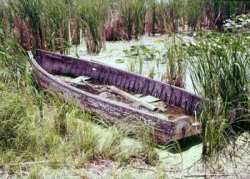 |
 |
| Home | Welcome | What's New | Site Map | Glossary | Weather Doctor Amazon Store | Book Store | Accolades | Email Us |
 | |||||||||
Weather Almanac for January 1998Weathering the ColdIn North America, winter has many different meanings as we move from the Canadian arctic to the American subtropics. While some birds and insects such as the Monarch butterfly are able to migrate southward to avoid the full blast of winter cold, many animals must seek shelter against the elements. A large number of animals residing south of the permafrost zone of the high north seek the warmth of the earth as shelter. Why is the ground such a good shelter for active living or hibernation? In large part due to the insulating properties of snow and soil. While snow is colder than freezing, the air spaces between the snow crystals serve as insulation -- a deep-freeze duvet. With a sufficient depth of snow, the temperature of the upper layer of the snow may drop to very cold temperatures while that close to the ground may remain just below freezing. Similarly, in the soil, the upper layers may freeze solid, but subfreezing temperatures may not penetrate to great depth. How far the frost sinks into the soil is a function of the air temperature above, the length of the cold season, the amount and duration of snow cover, the soil water content and the nature of the soil. Light fluffy soils are better insulators than rocky ones. Leaf litter above the actual soil can serve as an additional insulating blanket. (This fact is exploited by gardeners who mulch their plants each winter to prevent frost damage.) In areas where the soil is deep, at depths of a metre or two (three to six feet), the soil temperature may not vary much over the year -- perhaps less than a degree or two while the surface temperature varies by 75 Celsius degrees (120 Fahrenheit degrees) or more. This allows some burrowing animals to live much of their lives in a fairly constant thermal environment which rivals those of humans. Caves provide similar shelter from the cold (and heat). For those animals that hibernate, a shelter providing a few degrees extra warmth can make the difference between survival or death. When in hibernation, the animal reduces its basic energy usage to a much lower level than during the non-hibernation state. For example, the thirteen-line ground squirrel decreases its overall energy consumption to 2% of its consumption when fully active. An animal such as a bear or mouse lives off fat reserves during this time. The amount of fat burned to keep the spark of life burning is dependent on the external temperature. Thus, if the animal hibernated in the open (desregarding threats from predators), it would be exposed to much colder temperatures and strong winds which rob the body of heat. By moving to a subterranean environment where temperatures are warmer and air movement light, the amount of fat burned decreases dramatically. If all fat were to be burned while the need for it continued, the animal would eventually freeze to death. Therefore, it is important for an animal to find a good resting spot for winter hibernation. Snow banks can provide shelter from extreme cold as well. Birds such as the grouse burrow into snow banks for warmth during extreme winter conditions. Even some small birds which we do not associate with ground-living like the grouse have been observed to burrow into a snow bank for shelter, adding the insulation of the light snow to that of their feathers. Mice and other small mammals tunnel beneath the snow providing a protective pathway between their burrows and food storage sites. Not only do these tunnels protect these animals from the elements, they provide a means of ventilation by which fresh air can enter their burrows. While some life rests during the winter, under the snow and in the soil, another world remains alive, awaiting the onset of spring. Learn More From These Relevant Books
|
|||||||||
 |
To Purchase Notecard, |
Now Available! Order Today! | |
 |
 |
NEW! Now |
The BC Weather Book: |


